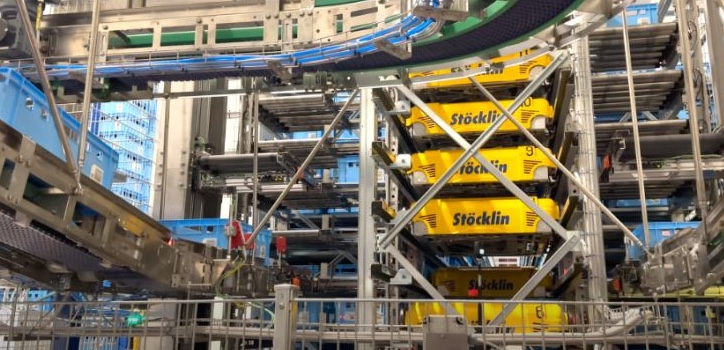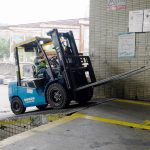The global supply chain can be re-shaped by the greater usage of ASRS, writes Danilo Potocnik, Head of Sales, Stoecklin Logistics.
As today’s supply chain continues to become more complicated and consumer demands climb, warehouses and distribution centers (DCs) are under increasing pressure to streamline operations and improve accuracy without compromising on workplace safety. Luckily, automated storage and retrieval systems (ASRS), are here to help. Although some have already adopted ASRS technology in their operations, studies have found that the global ASRS market is expected to grow from approximately $9 billion USD in 2023 to $15 billion by 2032. Factors driving this rapid adoption include:
1. Streamlined operations for enhanced efficiency
Many turn to an ASRS for its ability to drastically improve operational efficiency. Traditional warehouses can be labor intensive, requiring manual picking, packing, and storing goods. However an ASRS handles these tasks seemingly effortlessly, without the need for human intervention. Automated cranes and shuttles rapidly move the items to and from storage, significantly reducing the time it takes to fulfill orders. In high-density storage, ASRS solutions help optimize space utilization by storing goods in compact, densely packed areas—maximizing storage capacity, and eliminating the time it takes to search for items. Because automated systems can handle repetitive tasks with precision and speed, they enable faster turnaround times and fewer fulfillment errors.
2. Increased accuracy and reduced errors
Accuracy is essential in the supply chain and automated systems are equipped with advanced technology like sensors, cameras, and real-time processing capabilities to ensure precise tracking and inventory retrieval. By eliminating the risk for human error, an ASRS ensures stock levels are always accurate and only the intended goods are being picked from storage. An ASRS can automatically sort and route items, reducing the chance of misplaced inventory. This level of precision improves customer satisfaction by ensuring orders are accurately fulfilled and reduces costs associated with potential returns and rerouted goods.
3. Scalability for growing demands
Because of the unpredictability of the supply chain, having a solution that is scalable with demand is critical. Thankfully, an ASRS is flexible and can adjust to shifting needs without requiring major changes to the structure of the warehouse. The modularity of the solutions allow for easy reconfiguration to handle varying inventory levels and changing order volumes. In peak seasons for example, an ASRS can be quickly reconfigured to handle increased throughput. Having a scalable solution is essential for companies looking to remain competitive, allowing them to manage larger volumes of inventory and fulfill orders more efficiently without compromising on quality.
4. Addressing labour challenges and safety concerns
Additionally, labour shortages remain a pressing challenge in warehouses and DCs. Driven by demographic shifts, mass retirements, and evolving job market expectations, labor shortages can cause significant delays. However, an ASRS reduces the reliance on manual labor and is able to work around the clock to fulfill orders. Relying on an ASRS allows human workers to focus on more valuable activities. Additionally, ASRS solutions enhance workplace safety by handling hazardous tasks and heavy lifting, reducing the risk of injuries. By minimizing human intervention, warehouses and DCs can create safer working environments and improve overall operational safety.

5. Promoting sustainability and reducing environmental impacts
With a growing awareness about environmental impacts, sustainability has become a leading priority for businesses around the world. ASRS solutions play a key role in promoting eco-conscious supply chain practices like making better use of space. By cutting down the need for big warehouse facilities, automated systems help save energy, environmental habitats, and shrink carbon footprint linked to large-scale operations. And, with maximum precision, automated systems reduce the risk for wasted goods and materials. Additionally, many ASRS solutions are designed with energy-saving features like regenerative braking and efficient power management to further improve sustainability.
6. Integrating with advanced technologies
The benefits of an ASRS solution only get better when combined with other advanced technologies. When you integrate these systems, you can predict when maintenance will be needed, keep an eye on operations in real time, and make smarter decisions — all of which boost the overall effectiveness of automated systems. For example, integrated advanced AI algorithms can help analyze data from an ASRS to help predict potential issues before they occur, allowing for proactive maintenance and reducing downtime.
Forward-thinking
It’s clear that automation is transforming warehousing and distribution. By enhancing efficiency, accuracy, scalability, and sustainability, ASRS are not only optimizing operations but are setting new industry standards. As technology continues to advance, automation will continue to reshape the future of supply chain management — -driving innovation and fostering greater resilience in an increasingly complex global marketplace.
similar news
The post Reshaping the Global Supply Chain with ASRS appeared first on Logistics Business.


